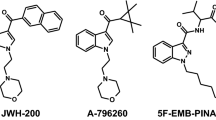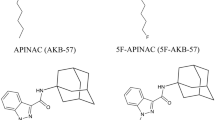Abstract
The number of new psychoactive substances (NPS) emerging on the illicit drug market has increased over the last decade. Halogenation of existing illicit drugs is a particular trend, with the purpose of both circumventing the law and altering the toxicodynamic and toxicokinetic profiles of the compounds. This study investigates the in vitro impact of JWH-122 ω-halogenation (fluoro, chloro, bromo and iodo) on the metabolism, apparent intrinsic hepatic clearance and analytical targets for detecting drug consumption. Metabolite profiling was conducted with pooled human liver microsomes, suspended rat hepatocytes and pooled human hepatocytes. The in vitro half-life was also determined in pooled human hepatocytes. All samples were analysed by liquid chromatography/high-resolution mass spectrometry. All compounds, except for JWH-122, showed high formation rates of phase I metabolites, predominantly ω-COOH and methylnaphthyl hydroxylation metabolites. Phase II metabolites were ω-O-glucuronides, methylnaphthyl O-glucuronides and ω-glutathione conjugates. The relative ion intensity of the glutathione conjugates increased with the ω-halogen size, with I-JWH-122 having the highest intensity. Stability studies gave a low half-life and a high intrinsic hepatic clearance for JWH-122 (1305 mL/min/kg) and MAM-2201 (1408 mL/min/kg). Cl-, Br- and I-JWH-122 showed increasing half-life with increasing ω-halogen size, with intrinsic clearance values of 235–502 mL/min/kg. The recommended analytical targets for consumption of JWH-122 or ω-halogenated JWH-122 analogues are the ω-COOH metabolites for unspecific profiling and the methylnaphthyl hydroxylated metabolites to distinguish the compounds. Furthermore, ω-halogenation with larger halogens appears to increase the intrinsic hepatic stability, thereby prolonging exposure and possibly the duration of action.



Similar content being viewed by others
References
European Monitoring Centre for Drugs and Drug Addiction. Fentanils and synthetic cannabinoids: driving greater complexity into the drug situation. An update from the EU Early Warning System (June 2018). Luxembourg: Publications Office of the European Union; 2018.
Saito T, Namera A, Miura N. A fatal case of MAM-2201 poisoning. Forensic Toxicol. 2013;31(2):333–7.
Derungs A, Schwaninger AE, Mansella G, Bingisser R, Kraemer T, Liechti ME. Symptoms, toxicities, and analytical results for a patient after smoking herbs containing the novel synthetic cannabinoid MAM-2201. Forensic Toxicol. 2013;31(1):164–71.
Roman M, Wu X, Diao X, Josefsson M, Eriksson C, Kugelberg FC, et al. 25C-NBOMe and 25I-NBOMe metabolite studies in human hepatocytes, in vivo mouse and human urine with high-resolution mass spectrometry. Drug Test Anal. 2016;9(5):680–98.
Lewin AH, Seltzman HH, Carroll FI, Mascarella SW, Reddy PA. Emergence and properties of spice and bath salts: a medicinal chemistry perspective. Life Sci. 2014;97(1):9–19.
Diao X, Wohlfarth A, Pang S, Scheidweiler KB, Huestis MA. High-resolution mass spectrometry for characterizing the metabolism of synthetic cannabinoid THJ-018 and its 5-Fluoro analog THJ-2201 after incubation in human hepatocytes. Clin Chem. 2016;62(1):157–69.
Vigolo A, Ossato A, Trapella C, Vincenzi F, Rimondo C, Seri C, et al. Novel halogenated derivates of JWH-018: behavioral and binding studies in mice. Neuropharmacology. 2015;95:68–82.
Noble C, Cannaert A, Linnet K, Stove CP. Application of an activity-based receptor bioassay to investigate the in vitro activity of selected indole- and indazole-3-carboxamide-based synthetic cannabinoids at CB1 and CB2 receptors. Drug Test Anal. 2019;11(3):501–11.
Cannaert A, Storme J, Franz F, Auwärter V, Stove CP. Detection and activity profiling of synthetic cannabinoids and their metabolites with a newly developed bioassay. Anal Chem. 2016;88(23):11476–85.
Winstock AR, Barratt MJ. Synthetic cannabis: a comparison of patterns of use and effect profile with natural cannabis in a large global sample. Drug Alcohol Depend. 2013;131(1–2):106–11.
Rane A, Wilkenson GR, Shand DG. Prediction of hepatic extraction ratio from in vitro measurement of intrinsic clearance. J Pharmacol Exp Ther. 1977;200(2):420–4.
Gómez-lechón MJ, Tolosa L, Conde I, Donato MT. Competency of different cell models to predict human hepatotoxic drugs. Expert Opin Drug Metab Toxicol. 2014;10(11):1553–68.
Castell JV, Jover R, Martnez-Jimnez CP, Gmez-Lechn MJ. Hepatocyte cell lines: their use, scope and limitations in drug metabolism studies. Expert Opin Drug Metab Toxicol. 2006;2(2):183–212.
Asha S, Vidyavathi M. Role of human liver microsomes in in vitro metabolism of drugs — a review. Appl Biochem Biotechnol. 2010;160(6):1699–722.
Di L, Keefer C, Scott DO, Strelevitz TJ, Chang G, Bi Y-A, et al. Mechanistic insights from comparing intrinsic clearance values between human liver microsomes and hepatocytes to guide drug design. Eur J Med Chem. 2012;57(6):441–8.
Noble C, Mardal M, Bjerre Holm N, Stybe Johansen S, Linnet K. In vitro studies on flubromazolam metabolism and detection of its metabolites in authentic forensic samples. Drug Test Anal. 2017;9(8):1182–91.
Wohlfarth A, Pang S, Zhu M, Gandhi AS, Scheidweiler KB, Huestis MA. Metabolism of RCS-8, a synthetic cannabinoid with cyclohexyl structure, in human hepatocytes by high-resolution MS. Bioanalysis. 2014;6(9):1187–200.
Soars MG, Grime K, Sproston JL, Webborn PJH, Riley RJ. Use of hepatocytes to assess the contribution of hepatic uptake to clearance in vivo. Drug Metab Dispos. 2007;35(6):859–65.
Obach RS, Baxter JG, Liston TE, Silber BM, Jones BC, MacIntyre F, et al. The prediction of human pharmacokinetic parameters from preclinical and in vitro metabolism data. J Pharmacol Exp Ther. 1997;283(1):46–58.
Poulin P, Haddad S. Toward a new paradigm for the efficient in vitro–in vivo extrapolation of metabolic clearance in humans from hepatocyte data. J Pharm Sci. 2013;102(9):3239–51.
Kim J-H, Kong TY, Moon J-Y, Choi KH, Cho Y-Y, Kang HC, et al. Targeted and non-targeted metabolite identification of MAM-2201 in human, mouse, and rat hepatocytes. Drug Test Anal. 2018;10(8):1328–35.
Jang M, Shin I, Yang W, Chang H, Yoo HH, Lee J, et al. Determination of major metabolites of MAM-2201 and JWH-122 in in vitro and in vivo studies to distinguish their intake. Forensic Sci Int. 2014;244:85–91.
Kong TY, Kim J-H, Choi WG, Lee JY, Kim HS, Kim JY, et al. Metabolic characterization of (1-(5-fluoropentyl)-1H-indol-3-yl)(4-methyl-1-naphthalenyl)-methanone (MAM-2201) using human liver microsomes and cDNA-overexpressed cytochrome P450 enzymes. Anal Bioanal Chem. 2017;409(6):1667–80.
Meyer MR, Richter LHJ, Maurer HH. Methylenedioxy designer drugs: mass spectrometric characterization of their glutathione conjugates by means of liquid chromatography-high-resolution mass spectrometry/mass spectrometry and studies on their glutathionyl transferase inhibition potency. Anal Chim Acta. 2014;822:37–50.
Sharma M, Tomasz M. Conjugation of glutathione and other thiols with bioreductively activated mitomycin C. Effect of thiols on the reductive activation rate. Chem Res Toxicol. 1994 May;7(3):390–400.
Hutter M, Broecker S, Kneisel S, Auwärter V. Identification of the major urinary metabolites in man of seven synthetic cannabinoids of the aminoalkylindole type present as adulterants in ‘herbal mixtures’ using LC-MS/MS techniques. J Mass Spectrom. 2012;47(1):54–65.
Baars AJ, Mukhtar H, Zoetemelk CEM, Jansen M, Breimer DD. Glutathione s-transferase activity in rat and human tissues and organs. Comp Biochem Physiol C Comp Pharmacol. 1981;70(2):285–8.
Mardal M, Gracia-Lor E, Leibnitz S, Castiglioni S, Meyer MR. Toxicokinetics of new psychoactive substances: plasma protein binding, metabolic stability, and human phase I metabolism of the synthetic cannabinoid WIN 55,212-2 studied using in vitro tools and LC-HR-MS/MS. Drug Test Anal. 2016;8(10):1039–48.
Liu X, Wright M, Hop CECA. Rational use of plasma protein and tissue binding data in drug design. J Med Chem. 2014;57(20):8238–48.
Kong TY, Kim J-H, Kim DK, Lee HS. Synthetic cannabinoids are substrates and inhibitors of multiple drug-metabolizing enzymes. Arch Pharm Res. 2018;41(7):691–710.
Teske J, Weller J-P, Fieguth A, Rothämel T, Schulz Y, Tröger HD. Sensitive and rapid quantification of the cannabinoid receptor agonist naphthalen-1-yl-(1-pentylindol-3-yl)methanone (JWH-018) in human serum by liquid chromatography–tandem mass spectrometry. J Chromatogr B. 2010;878(27):2659–63.
Lonati D, Buscaglia E, Papa P, Valli A, Coccini T, Giampreti A, et al. MAM-2201 (analytically confirmed) intoxication after “synthacaine” consumption. Ann Emerg Med. 2014;64(6):629–32.
Acknowledgements
The authors acknowledge Carolina Noble and Niels Bjerre Holm for their support and contribution to this work.
Author information
Authors and Affiliations
Corresponding author
Ethics declarations
Conflict of Interest
The authors declare that they have no conflict of interest.
Ethical Approval
This article does not contain any studies with human participants or laboratory animals performed by the authors.
Additional information
Publisher’s Note
Springer Nature remains neutral with regard to jurisdictional claims in published maps and institutional affiliations.
Electronic Supplementary Material
ESM 1
(DOCX 231 kb)
Rights and permissions
About this article
Cite this article
Davidsen, A.B., Mardal, M. & Linnet, K. In Vitro Metabolism and Hepatic Intrinsic Clearance of the Synthetic Cannabinoid Receptor Agonist JWH-122 and Its Four ω-Halogenated Analogues. AAPS J 21, 63 (2019). https://doi.org/10.1208/s12248-019-0338-6
Received:
Accepted:
Published:
DOI: https://doi.org/10.1208/s12248-019-0338-6




